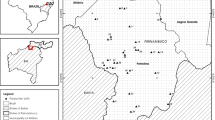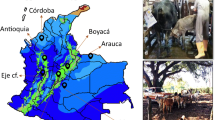Abstract
Eimeria spp. infections lead to acute or chronic intestinal disorders in small ruminants, being responsible for important economic losses worldwide. The aim of this study was to assess the risk factors associated with Eimeria spp. infection in small ruminants of the microregion of Garanhuns, state of Pernambuco, Northeastern Brazil. Fecal samples (n = 822) were obtained from goats (n = 414) and sheep (n = 408) and evaluated by the modified Gordon and Whitlock technique. Risk factors were assessed through univariate analysis and logistical regression. Oocysts of Eimeria species were detected in 62.9% (517/822) of the animals, with 77.8% (322/414) in goats and 47.8% (195/408) in sheep. For goats, the herd size (OR = 5.52), rearing system (OR = 1.57), feeding place (OR = 2.60), absence of mineral salt in the diet (OR = 2.54), flooring type (OR = 2.83) and periodicity of cleaning (OR = 5.39) were considered risk factors. Conversely, for sheep only the herd size (OR = 3.16) and rearing system (OR = 2.45) were important factors associated with infection by Eimeria spp. Data herein obtained brings meaningful information on the epidemiology of coccidiosis in small ruminants in Northeastern Brazil. The knowledge of these risk factors is useful to contribute to the development of preventive measures, thereby, reducing the economic impact caused by these protozoa in small ruminant production.



Similar content being viewed by others
References
Andrade Júnior ALF, Silva PC, Aguiar EM, Santos FGDA (2012) Use of coccidiostat in mineral salt and study on ovine eimeriosis. Braz J Vet Parasitol 21:16–21
Bakunzi FR, Thwane SN, Motsei LE, Dzoma BM (2010) Diversity and seasonal occurrence of Eimeria species in a mixed flock of communally reared sheep and goats in Mafikeng in the North West Province, South Africa. J S Afr Vet Assoc 81:148–150
Carrau T, Silva LMR, Pérez D, Failing K, Mantínez-Carrasco C, Macías J, Taubert A, Hermosilla C, Ruiz Y (2018) Associated risk factors influencing ovine Eimeria infections in southern Spain. Vet Parasitol 263:54–58
Chartier C, Paraud C (2012) Coccidiosis due to Eimeria in sheep and goats, a review. Small Rumin Res 103:84–92
Foreyt WJ (1990) Coccidiosis and cryptosporidiosis in sheep and goats. Vet Clin North Am Food Anim Pract 6:655–669
Gordon HM, Whitlock HV (1939) A new technique for counting nematode eggs in sheep faeces. J Sci Ind Res 12:50–52
Grilo ML, Carvalho LM (2014) Coccidiose em ruminantes pequenos agentes e grandes problemas nas diarreias parasitárias. Prev Vet Med 1:34–48
Hashemnia M, Rezaei F, Chalechale A (2015) Prevalence, intensity, and pathological lesions of Eimeria infection in goats in western Iran. Comp Clin Path 24:805–810
IBGE-Instituto Brasileiro de Geografia e Estatística (2016) Cidades—Produção da Pecuária Municipal
Lassen B, Østergaard S (2012) Estimation of the economical effects of Eimeria infections in Estonian dairy herds using a stochastic model. Prev Vet Med 106:258–265
Lopez-Osorio S, Villar D, Failing K, Taubert A, Hermosilla C, Chaparro-Gutierrez JJ (2019) Epidemiological survey and risk factor analysis on Eimeria infections in calves and young cattle up to 1 year old in Colombia. Parasitol Res 1:1–12
Makau DN, Gitau GK, Muchemi GK, Thomas LF, Cook EAJ, Wardrop NA, Fèvre EM, Glanville WA (2017) Environmental predictors of bovine Eimeria infection in western Kenya. Trop Anim Health Prod 49:409–416
Ozmen O, Adanir R, Haligur M (2012) Immunohistochemical detection of the cytokine and chemokine expression in the gut of lambs and kids with coccidiosis. Small Rumin Res 105:345–350
Rehman T, Khan MN, Sajid MS, Abbas RZ, Arshad M, Iqbal A (2011) Epidemiology of Eimeria and associated risk factors in goats of district Toba Tek Singh, Pakistan. Indian J Anim Sci 82:282–285
Reis JC (2003) Estatística aplicada à pesquisa em ciência veterinária, Copyright, Recife, Brasil
Saratsis A, Joachim A, Alexandros S, Sotiraki S (2011) Lamb coccidiosis dynamics in different dairy production systems. Vet Parasitol 181:131–138
Sharma DK, Paul S, Rout PK, Mandal A, Bhusan S, Sharma N, Kushwah YK (2017) Caprine coccidiosis in semi-arid India: dynamics and factors affecting fecal oocysts count. J Adv Vet Anim Res 4:52–57
Silva TP, Facury Filho EJ, Nunes ABV, Albuquerque FHMAR, Ferreira PM, Carvalho AU (2007) Dinâmica da infecção natural por Eimeria spp. em cordeiros da raça Santa Inês criados em sistema semi-intensivo no Norte de Minas Gerais. Braz J Vet Res Anim Sci 59:1468–1472
Souza LEB, Cruz JF, Teixeira Neto MR, Albuquerque GR, Melo ADB, Tapia DMT (2015) Epidemiology of Eimeria infections in sheep raised extensively in a semiarid region of Brazil. Braz J Vet Parasitol 24:410–415
Squire SA, Robertson ID, Yang R, Avi I, Ryana U (2019) Prevalence and risk factors associated with gastrointestinal parasites in ruminant livestock in the Coastal Savannah zone of Ghana. Acta Trop 199:105126
Thrusfield MV (2004) Epidemiologia Veterinária, 2nd edn. Roca, São Paulo
Young G, Alley ML, Foster DM, Smith GW (2011) Efficacy of amprolium for the treatment of pathogenic Eimeria species in Boer goat kids. Vet Parasitol 178:346–349
Acknowledgements
Authors would like thank Bronwyn Campbell for her suggestions on the manuscript. Authors also thank the Coordenação de Aperfeiçoamento de Pessoal de Nível Superior (CAPES) for the financial support. This study resulted from a Master of Science dissertation of the first author (Postgraduate Program in Ruminants Health and Reproduction), developed at the Federal Rural University of Pernambuco.
Author information
Authors and Affiliations
Corresponding author
Ethics declarations
Conflict of interest
The authors declare that they have no Conflict of interest.
Ethical statement
This study was approved by the Ethics Committee for Animal Experimentation (ECAE) of the Universidade Federal Rural de Pernambuco under the license number: 06/2017. All applicable international, national, and/or institutional guidelines for the care and use of animals enrolled in the present study were followed.
Additional information
Publisher's Note
Springer Nature remains neutral with regard to jurisdictional claims in published maps and institutional affiliations.
Rights and permissions
About this article
Cite this article
de Macedo, L.O., Bezerra-Santos, M.A., de Mendonça, C.L. et al. Prevalence and risk factors associated with infection by Eimeria spp. in goats and sheep in Northeastern Brazil. J Parasit Dis 44, 607–612 (2020). https://doi.org/10.1007/s12639-020-01235-3
Received:
Accepted:
Published:
Issue Date:
DOI: https://doi.org/10.1007/s12639-020-01235-3




